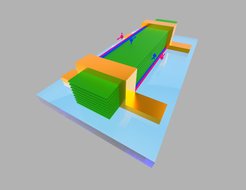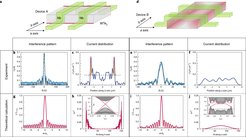Higher Order Topology Discovered in the 2D material WTe2
From Topological Insulators, to Dirac and Weyl semimetals, scientists in recent years have found a variety of exotic topological materials with exotic properties. Now, so-called “higher order topological insulators”, or HOTI’s for short, have been predicted which have insulating bulks and surfaces but can have conducting hinges and corners. Hinge states have also been predicted to exist in topological semimetals as extra conducting channels. So far, only Bismuth had been experimentally confirmed to show this unusual behavior.

To understand a “hinge state”, imagine a box – longer and wider than tall – with flaps on the top and bottom that you open when putting things inside. The inside of this box would be called the “bulk” and most materials conduct electricity in the bulk. However, in topological insulators, the bulk of the box is electrically insulating, but the top and bottom have conducting “surface states”. For some materials, the bulk, top and bottom of the box are all insulating, but the sides (a.k.a. the edges) are metallic. These conducting “edge states” been shown, for example, in magnetic topological insulators. In HOTI’s the bulk, top, bottom and sides of the box are all insulating. But the hinges or corners of the box are metallic and have conducting “hinge states” and “corner states”. These hinge states have also been predicted to exist in topological semimetals like WTe2 and Bi. Hinge states are expected to be promising for spintronics (because the direction of their propagation is tied to their spin) as well as for realizing Majorana fermions which are actively being investigated for their applications to fault-tolerant quantum computing.
In a collaboration led by Dr. Kin Chung Fong, Dr. Kam Tuen Law, Dr. Gil-Ho Lee, and Dr. Mazhar N. Ali, the team used Josephson Junctions to induce superconductivity in WTe2 and show that it hosts anisotropic hinge states, which carry the supercurrent, on certain hinges of the crystal.
Josephson Junctions are formed by connecting two superconducting electrodes (like Nb) across a bridge of non-superconducting material (WTe2). At low temperatures and short distances, the injected supercurrent from one Nb electrode can propagate through the WTe2 bridge to the other Nb electrode without resistive loss. However the critical current (the maximum amount of current a superconductor can carry before reverting to a normal conductor) across the junction can be modulated by an external magnetic field, forming an oscillatory pattern known as a Fraunhofer diffraction pattern. This pattern contains information on the spatial location of the supercurrent in the sample.

The team took advantage of this fact and realized that different surface/edge/hinge states all have different fingerprints in the Fraunhofer pattern. Through careful and clever device fabrication where they connected Nb only to certain hinges and edges of the samples and by applying magnetic fields in different directions, they were able to show that WTe2 indeed has hinge states. Additionally, the hinge states were not all equivalent; since WTe2 is a fairly low-symmetry material with high crystalline anisotropy, the hinge states mixed into the bulk only in some directions and not in others.
Based on this work, WTe2, and sister material MoTe2, are exciting materials to investigate for dissipationless interconnections, true 1D superconducting nano-wires, spintronics devices, topological superconductivity, Majorana fermions and correspondingly topological quantum computing. While WTe2 may be the second material shown to host hinge states, it is very different from the other candidate, Bismuth. WTe2, being 2D, is easily fabricable into nano-devices with controlled surfaces, can be layered on top of other 2D materials in heterostructures, and even on top of itself, when slightly twisted, to form a Moire superlattice. There are many exciting research opportunities ahead in understanding how to modify, control, and use the hinge states in these materials.













